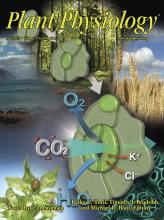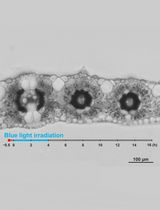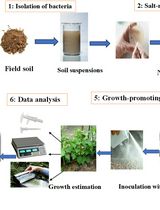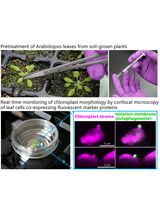- EN - English
- CN - 中文
Histochemical Preparations to Depict the Structure of Cauliflower Leaf Hydathodes
用于研究花椰菜叶泌水孔结构的组织化学制备
发布: 2017年10月20日第7卷第20期 DOI: 10.21769/BioProtoc.2452 浏览次数: 8450
评审: Hiroyuki HiraiYunbing MaAnonymous reviewer(s)
Abstract
Hydathodes are plant organs present on leaf margins of a wide range of vascular plants and are the sites of guttation. Both anatomy and physiology of hydathodes are poorly documented. We have recently reported on the anatomy of cauliflower and Arabidopsis thaliana hydathodes and on their infection by the vascular pathogenic bacterium Xanthomonas campestris pv. campestris (Xcc) (Cerutti et al., 2017). Because hydathodes are natural infection routes for several pathogens, it is necessary to have a deep knowledge of their anatomy to further better interpret images of infected hydathodes. Here, we described different detailed protocols for gaining information on hydathode anatomy which are applicable to a wide range of plants (including monocots like barley and rice). Nomarsky and confocal microscopy were used to observe clarified thick samples. Optical microscopy in transmitted light and transmission electron microscopy were used to observed thin and ultrathin sections.
Keywords: Cauliflower (花椰菜)Background
In literature, different techniques were used to study hydathodes (Perrin, 1972; Chen and Chen, 2007; Wang et al., 2011; Singh, 2014). From light microscopy (on entire tissues or on section of resin-embedded samples) to scanning or transmission electron microscopy, a large panel of protocols and techniques was available. To our knowledge, these techniques were not used in combination and laser confocal microscopy was never used to depict hydathode structures. Moreover, we noticed variations from protocols to protocols. We presented here different techniques used in combination. They are well-adapted to cauliflower and Arabidopsis thaliana. They have been successfully applied to other plants like monocotyledons (barley and rice) and should be likely used to a larger variety of plant species. We encourage the users to apply these protocols to gain complementary information on the hydathode at different scales during infection.
Materials and Reagents
- Microscope glass slides (Thermo Fisher Scientific, Superfrost, catalog number: 10143560WCUT )
- Cover slip 24 x 60 mm (Thermo Fisher Scientific, catalog number: 15747592 )
- Razor blades
- Cauliflower (Brassica oleracea var. botrytis, cultivar Clovis)
Notes:- Cauliflower plants were grown in a controlled greenhouse.
- All the experiments used the second true leaf from four-weeks-old plants.
- Cauliflower plants were grown in a controlled greenhouse.
- Chloral hydrate (Sigma-Aldrich, catalog number: 23100 )
- Glycerol (C3H8O3) (VWR, catalog number: 24387.326 )
- Calcofluor (Fluorescent Brightener 28) (Sigma-Aldrich, catalog number: F3543 )
- Triton X-100 (Sigma-Aldrich, catalog number: T8787 )
- Sodium cacodylate (Sigma-Aldrich, catalog number: C4945 )
- Glutaraldehyde EM grade (Electron Microscopy Sciences, catalog number: 16214 )
- Osmium tetroxide (OsO4) (Electron Microscopy Sciences, catalog number: 19150 )
- Ethanol (C2H5OH) (Sigma-Aldrich, catalog number: 32221 )
- Epon (Electron Microscopy Sciences, catalog number: 14120 )
Note: Composition of the resin: Embed-812 (45 g), DDSA (36 g), NMA (18 g) and BDMA (1.35 ml). Embedding kit in which accelerator DMP30 is replaced by BDMA (Electron Microscopy Sciences, catalog number: 11400 ). - Borax (Sigma-Aldrich, catalog number: B3545 )
- Toluidine blue (RAL Diagnostics, catalog number: 361590 )
- Methylene blue (Merck, catalog number: 159270 )
- Basic fuchsin (Sigma-Aldrich, catalog number: 857343 )
- Periodic acid (VWR, Prolabo, catalog number: 20.593.151 )
- Acetic acid (CH3COOH) (CARLO ERBA Reagents, catalog number: 302016 )
- Thiocarbohydrazide (Sigma-Aldrich, catalog number: 223220 )
- Silver proteinate (Roques for histology) (Sigma-Aldrich, catalog number: 05495 )
- Aceton (CH3COCH3) (Fisher Scientific, catalog number: 10395640 )
- Clarification solution (see Recipes)
- Fixation solution (see Recipes)
- Sodium cacodylate buffer (see Recipes)
- Borax solution with toluidine blue and methylene blue (see Recipes)
- Basic fuchsin solution (see Recipes)
- Periodic acid solution (see Recipes)
- Silver proteinate solution (see Recipes)
Equipment
- Hollow punch (Harris, Uni-Core) (Electron Microscopy Sciences, catalog number: 69039-70 )
- Ultra-microtome (Leica Microsystems, Reichert-Jung, model: UltraCut E )
- Optical microscope equipped for Nomarski (Leica Microsystems, model: DM IRB-E )
- Confocal microscope (Leica Microsystems, model: Leica TCS SP2 ) equipped with a diode laser at 405 nm
- Diaphragm pump vacuum or other vacuum sources
- Stirrer hotplate (IKA)
- Microwave apparatus (Leica Microsystems, model: EM AMW )
- Flat bottom embedding capsule (Electron Microscopy Sciences, catalog number: 70021 )
- Oven (Memmert, model: UFE500BO )
- Histo diamond knife (Diatome Histo) for semi-thin sections (0.5 µm) to optical observations
- Ultra diamond knife (Diatome Ultra 45) for ultra-thin sections (70-80 nm) to transmission electron microscopy
- Hot plate (slides warmer) (C & A Scientific, Premiere, model: XH-2002 )
- Optical microscope (ZEISS, model: Axioplan 2 )
- CCD camera (ZEISS, model: AxioCam MRc )
- Transmission electron microscope (Hitachi, model: HT7700 )
- Gold grid (Electron Microscopy Sciences, catalog number: FCF200-Au )
Software
- Pro Plus 4.0 Imaging software (Media Cybernetics, Silver Spring, MD, USA)
Procedure
文章信息
版权信息
© 2017 The Authors; exclusive licensee Bio-protocol LLC.
如何引用
Readers should cite both the Bio-protocol article and the original research article where this protocol was used:
- Cerutti, A., Auriac, M., Noël, L. D. and Jauneau, A. (2017). Histochemical Preparations to Depict the Structure of Cauliflower Leaf Hydathodes. Bio-protocol 7(20): e2452. DOI: 10.21769/BioProtoc.2452.
- Cerutti, A., Jauneau, A., Auriac, M. C., Lauber, E., Martinez, Y., Chiarenza, S., Leonhardt, N., Berthomé, R. and Noël, L. D. (2017). Immunity at cauliflower hydathodes controls systemic infection by Xanthomonas campestris pv campestris. Plant Physiol 174(2): 700-716.
分类
植物科学 > 植物免疫 > 宿主-细菌相互作用
植物科学 > 植物细胞生物学 > 细胞成像
细胞生物学 > 细胞成像 > 固定组织成像
您对这篇实验方法有问题吗?
在此处发布您的问题,我们将邀请本文作者来回答。同时,我们会将您的问题发布到Bio-protocol Exchange,以便寻求社区成员的帮助。
Share
Bluesky
X
Copy link














